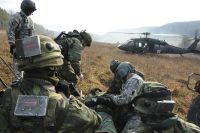WASHINGTON, Jan. 10, 2012 — Almost 300 troops from eight countries, all bound for Afghanistan to mentor Afghan national security forces, kicked off a rigorous pre-deployment training rotation yesterday in Hohenfels, Germany.
Ten operational mentor liaison teams converged on the Joint Multinational Readiness Center for 17 days of training designed to prepare them for a mission critical to the transition process and Afghanistan’s long-term security, Army Col. Jeffrey Martindale, the center commander, told American Forces Press Service.
“They are the bridge between conventional forces from all the NATO countries … and the Afghan national security forces” he said of OMLT teams that mentor Afghan military units as well as the newer police operational mentor liaison teams that work with police forces.
The teams are designed to build capabilities that will enable the Afghans to assume increasing security responsibility, he said. But Martindale said he sees a continuing, and even increasing, need for these teams as U.S. and NATO combat forces draw down in Afghanistan.
“In my mind, [OMLTS] will be the stay-behind [troops] as we tailor down the size of large conventional forces and hand portions of the country over to the Afghans,” he said.
At that point, he said, he envisions that OMLTs will remain embedded within Afghan security forces to ensure they can operate with U.S. and NATO enabling capabilities that remain on the ground.
Training at the Joint Multinational Readiness Center is designed to ensure strong OMLT capabilities through these evolving roles.
The current training, the 21st OMLT rotation since the summer of 2007, includes two teams from Czech Republic, Hungary and Bulgaria and one team each from Poland, Slovenia, Albania and Romania.
Each team arrived for the second phase of NATO OMLT training after completing the first phase predominantly individual skills and some lower-level collective skills at their home stations.
“This is really where we bring it all together,” Martindale explained. “This is where we focus on mentoring and [ensuring they are] self-sufficient enough to be able to shoot, move and communicate on their own when they are out, partnered with Afghan units.”
The Hohenfels training is designed to be as challenging and realistic as possible, said Army Lt. Col. William “Clark” Lindner, senior observer/controller for the OMLT training.
The cadre members apply their own experiences from recent Afghanistan deployments and regular feedback about changing conditions there to create training scenarios that reflect the latest tactics, techniques and procedures, he said.
In addition, the center routinely sends observer-controllers to Afghanistan to work with OMLT teams they trained to assess what training was worthwhile and what needs to be improved or changed, Linder said.
When OMLTs arrive at Hohenfels, their first days are dedicated to basic combat skills that enable forces to be self-sufficient on the battlefield, Lindner explained. Troops demonstrate their ability to react to fire, call for fire and for medevac support and to integrate rotary-wing assets, he said.
From there, the training moves directly to mentoring others carrying out these roles.
For the current rotation, 380 Romanian soldiers are playing the role of Afghan soldiers, receiving mentoring support as they conduct operations.
“We have found that we don’t really need to bring an Afghan battalion over here to get the same training effect,” Martindale said. “As long as you have a different set of soldiers that don’t speak the same language and are brought up in a different training environment, it still works out to be about the same thing.”
The mentors-in-training at Hohenfels almost half of them who have served previous Afghanistan deployments — monitor “Afghan unit” activities on two levels. They focus on how they conduct missions ranging from cordon-and-search operations to defense and hasty attacks. Meanwhile, senior-level mentors assess the planning and military decision-making processes the leaders make.
But the biggest lessons they work to instill, Martindale said, is the art of mentoring. “Every country approaches the mission a bit differently,” he said. “I would say those countries who fully embrace the mentorship side of it have the best effect when they are in theater.”
That, he said, means “not just leaving a protected [forward operating base], going out and doing a drive-by where they see their counterparts and check on them, then go back to the safe place.”
Rather, Martindale said the cadre strives to impress a different model of mentoring: “living with them, working with them, fighting with them all the time.”
“That is what we call mentoring. That is the U.S. model,” he said. “And that is what we try to impart onto our multinational partners here.”
When teams complete the Joint Multinational Readiness Center training, the JMRC cadre will certify whether they are ready to deploy. Some will return to their home bases for final pre-deployment training, but for others, Hohenfels will be their last training before departing for Afghanistan.
Lindner said he has received “overwhelming feedback” that the OMLT training paid off as teams arrived in the combat theater. Some said it caused them to address issues they hadn’t previously considered, but “that saved them when they got out into a fight.” Others said the training provided key information they applied when conducting operations.
With the amount of mentoring training the center provides typically four to five OMLT rotations per year and an increasing number of POMLTs since they began in mid-2010 — Martindale said JMRC is uniquely located and staffed to provide what’s recognized as a vital service.
“We have the unique capability of bringing all the NATO partners here,” both for training and to serve on observer-controller teams, he said.
In doing so, Lindner said it enables some NATO countries, particularly those that can’t contribute battalion- or brigade-size elements, to be partners in the ISAF mission.
By helping them field qualified OMLT teams, he said, the center helps give them the opportunity to make “a very credible contribution” in Afghanistan.
Source:
U.S. Department of Defense
Office of the Assistant Secretary of Defense (Public Affairs)

 von
von 